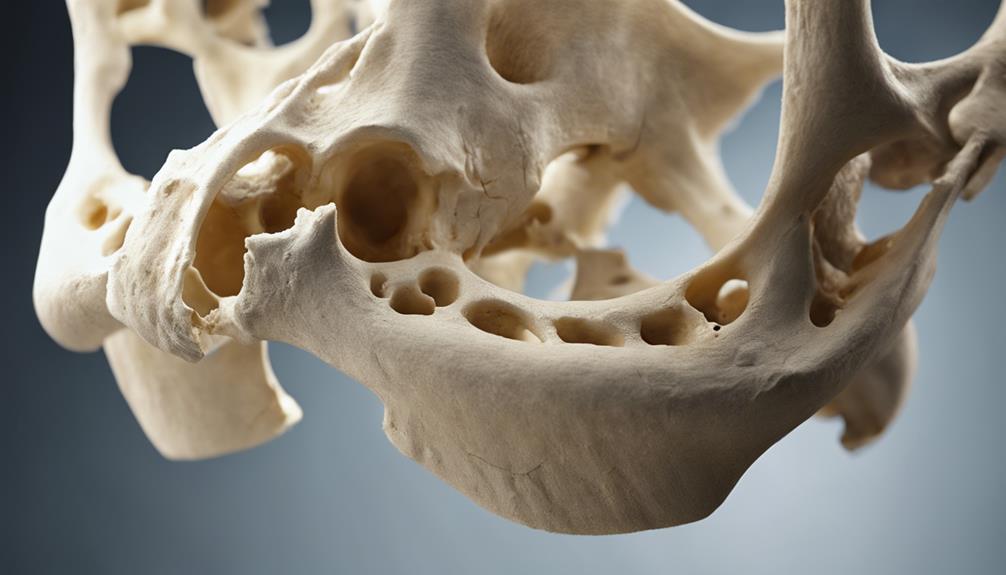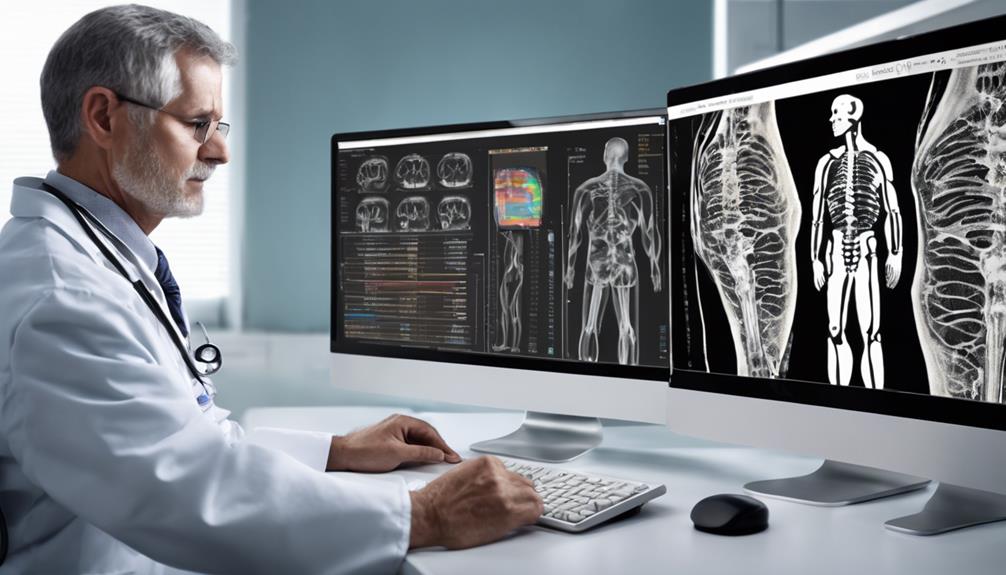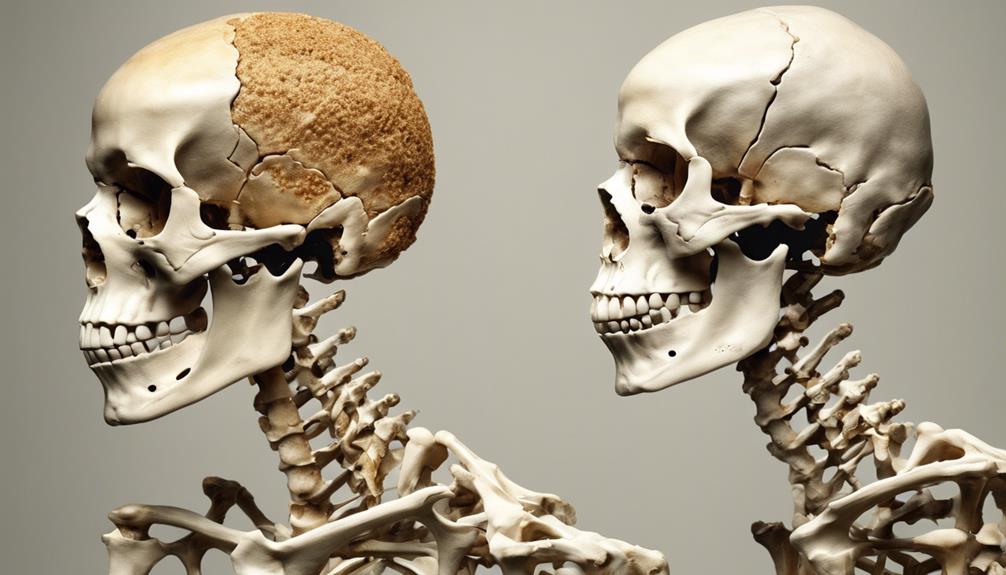When it comes to the health of our hip bones, it is crucial to stay attentive to a health issue. Osteoporosis can cause a subtle yet significant effect on our hips, resulting in lasting consequences.
Let's explore how this condition influences our daily lives and what steps can be taken to address it effectively.
Key Takeaways
- Weight-bearing exercises crucial for hip bone strength
- Adequate calcium and Vitamin D intake essential
- Surgical interventions may be necessary for hip fractures
- Prevention strategies focus on fall prevention and regular exercise
Causes of Osteoporosis in the Hip
In our examination of the causes of osteoporosis in the hip, we find that various factors such as obstruction of small blood vessels, hormonal changes, and abnormal mechanical stresses contribute to this condition. When small blood vessels around the hip are obstructed, it can lead to reduced blood flow, depriving the bone of essential nutrients and contributing to bone weakening.
Hormonal changes, particularly during pregnancy or menopause, can disrupt the delicate balance of bone remodeling, increasing the risk of osteoporosis in the hip. Additionally, abnormal mechanical stresses on the hip bone, such as excessive weightbearing, can accelerate bone loss and deterioration.
Understanding these causes of hip osteoporosis is crucial in providing effective treatment and prevention strategies. Treatment often involves a combination of lifestyle modifications, including weight-bearing exercises and adequate intake of Vitamin D to support bone health. By addressing the underlying causes, such as small blood vessel issues and hormonal imbalances, we can work towards alleviating the pain and discomfort associated with hip osteoporosis.
Symptoms and Diagnosis
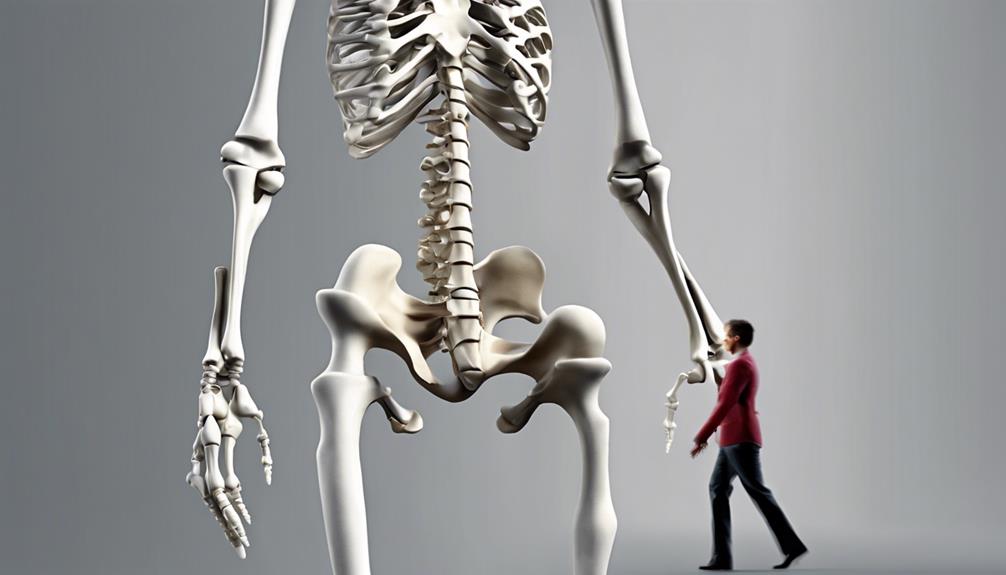
Exploring the realm of symptoms and diagnosis in hip osteoporosis reveals crucial indicators that can guide healthcare providers in identifying and addressing this condition effectively. Symptoms of hip osteoporosis often manifest as hip pain that worsens with weight bearing, limited hip motion, and gradual pain intensification over time. Individuals may develop a noticeable limp to protect the affected joint. It's essential to consider bone density, vitamin D levels, and bone loss as contributing factors to the development of hip osteoporosis.
Diagnosing hip osteoporosis involves a comprehensive approach, including a thorough medical history, physical examination, and imaging tests such as X-rays, CT scans, and MRI scans. These diagnostic tools help confirm the presence of osteoporosis in the hip joint. Healthcare providers may also consider anti-inflammatory medications to manage pain and inflammation associated with the condition. In cases where there's no history of joint injury but symptoms persist, a detailed evaluation is crucial for proper diagnosis and treatment planning.
Treatment Options Available
Our approach to treating hip osteoporosis involves a multifaceted strategy aimed at alleviating pain and improving joint function. NSAIDs can be used for pain relief, while weight-bearing restrictions may be recommended to reduce stress on the affected hip. The use of walking aids, such as canes or walkers, can provide support and decrease pressure on the hip joint, aiding in mobility and comfort.
Physical therapy plays a crucial role in hip osteoporosis treatment, focusing on building muscle strength and improving flexibility in the hip joint. Proper nutrition is essential, with a specific emphasis on adequate Vitamin D and calcium intake to promote bone health and support overall wellbeing.
In addition to these interventions, Vitamin D supplements may be prescribed to ensure optimal levels for bone health. By addressing pain management, mobility support, muscle strength, and nutritional needs, our comprehensive approach aims to enhance the quality of life for individuals with hip osteoporosis.
Prevention Strategies

Ensuring adequate calcium intake and engaging in weight-bearing exercises are paramount for preventing hip osteoporosis. These strategies help strengthen bones and reduce the risk of developing this debilitating condition.
Diet and Calcium Intake
To maintain optimal bone health, individuals aged 18-50 should ensure a daily calcium intake of 1,000mg through a balanced diet rich in dairy products, dark green leafy vegetables, and fortified soy products. Adequate vitamin D is crucial for calcium absorption and can be obtained from sunlight and fortified foods.
Consider calcium supplements if dietary intake is insufficient to meet daily requirements for bone health. Vitamin D sources like cod liver oil, trout, and fortified foods can help most individuals reach the recommended daily intake of at least 600 IU for optimal bone health.
- Ensure daily calcium intake of 1,000mg
- Include dairy products, dark green leafy vegetables, and fortified soy products in your diet
- Get enough vitamin D from sunlight and fortified foods
- Consider calcium supplements if needed.
Weight-Bearing Exercises
Engaging in weight-bearing exercises such as walking, running, and dancing is vital for strengthening bones in the hip and lower body to prevent hip osteoporosis. These activities stimulate bone formation, increase bone density, and reduce the risk of osteoporosis-related fractures. Weight-bearing exercises force bones to support the body's weight, promoting bone health and overall strength. Regular weight-bearing activities, when combined with adequate Vitamin D intake, help maintain bone mass and prevent bone loss. To ensure a safe and effective exercise routine tailored to individual needs, it's advisable to consult with a healthcare provider or a fitness expert. Prioritizing these exercises can significantly strengthen bones and lower the risk of hip fractures.
| Benefits of Weight-Bearing Exercises |
|---|
| Stimulates bone formation |
| Increases bone density |
| Reduces risk of fractures |
| Promotes overall bone strength |
| Helps maintain bone mass |
Managing Hip Fractures
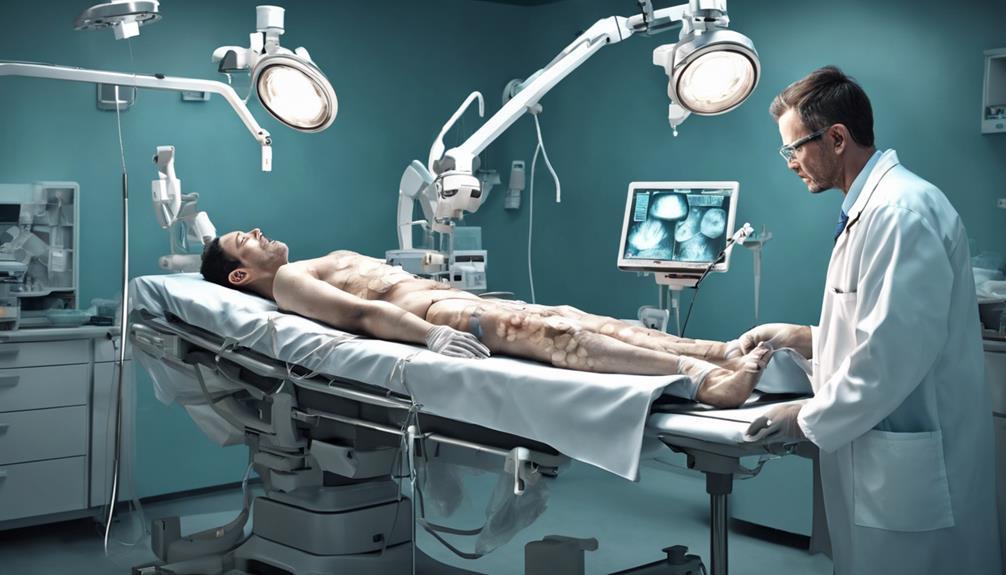
Surgical interventions such as hip replacement or fixation are commonly required to effectively manage hip fractures, a frequent consequence of osteoporosis, particularly among the elderly population. When dealing with hip fractures, it's essential to consider the best course of action to ensure optimal recovery and quality of life for the individual.
Complications can arise post-hip fracture, including immobility, infection risks, and a decline in overall well-being. Physical therapy is crucial in the journey of hip fracture recovery, aiding in rebuilding strength, restoring mobility, and promoting independence. Prevention strategies play a significant role in avoiding future hip fractures, emphasizing fall prevention techniques, maintaining bone health, and engaging in regular exercise to enhance balance and strength.
The elderly population, in particular, can benefit from tailored interventions and support to manage hip fractures effectively and improve their overall quality of life.
Lifestyle Changes for Bone Health

Let's focus on essential lifestyle changes that can significantly impact bone health, specifically in the context of preventing hip osteoporosis.
We'll explore the crucial elements of diet for bone health, exercise recommendations, and the importance of ensuring adequate calcium and vitamin D levels.
Diet for Bone Health
Promoting bone health through dietary choices is fundamental in preventing hip osteoporosis and maintaining skeletal strength. Ensuring adequate calcium intake from dairy products, dark green leafy vegetables, and fortified foods is crucial for optimal bone health.
Additionally, incorporating sources of Vitamin D, such as sunlight exposure and fortified foods, is essential for calcium absorption. Consider calcium supplements if dietary intake falls short of the recommended 1,000mg daily for adults aged 18-50 to support strong bones.
A balanced diet rich in calcium and Vitamin D is key to preventing osteoporosis and promoting overall bone strength.
Exercise Recommendations
Engaging in weight-bearing exercises like walking, jogging, and dancing is crucial for strengthening bones and reducing the risk of hip osteoporosis. Resistance training, involving weights or resistance bands, enhances bone density and muscle strength in the hips.
Incorporating balance and stability exercises such as tai chi or yoga improves coordination, reducing the likelihood of falls and hip fractures. To maintain bone health, aim for at least 150 minutes of regular physical activity per week.
Including a variety of lower body exercises that target different muscle groups supports overall hip bone strength and flexibility. By prioritizing these exercises, we can help prevent hip fractures and promote strong, healthy bones.
Calcium and Vitamin D
To support bone health and reduce the risk of hip osteoporosis, ensuring adequate intake of calcium and Vitamin D is essential for individuals aged 18-50. Men and women in this age group require 1,000mg of calcium daily, which can be found in dairy products, dark green leafy vegetables, and soy products.
Vitamin D plays a crucial role in calcium absorption and can be obtained from sunlight and fortified foods. If dietary intake of calcium is insufficient, consider calcium supplements to maintain optimal bone mass. Sources of Vitamin D include cod liver oil, trout, and fortified foods, with most adults needing at least 600 IU daily to promote bone health.
Frequently Asked Questions
How Serious Is Osteoporosis in the Hip?
Osteoporosis is a serious condition that can have profound consequences on one's health. It leads to weakened bones, making them more prone to fractures.
The hip, in particular, is a critical area affected by osteoporosis, with fractures in this region causing significant pain, immobility, and even mortality.
Proper management and treatment of osteoporosis are crucial to prevent these serious outcomes and maintain quality of life.
What Is the Best Treatment for Hip Osteoporosis?
When treating hip osteoporosis, we prioritize a holistic approach.
Through a combination of NSAIDs for pain relief, weight-bearing restrictions, physical therapy to enhance muscle strength, and a balanced diet rich in Vitamin D and calcium, we aim to support bone health and overall well-being.
Implementing walking aids as needed can further alleviate strain on the hip joint, fostering a comprehensive treatment plan tailored to the individual's needs and promoting recovery.
Is Walking Good for Osteoporosis of the Hips?
Yes, walking is highly beneficial for maintaining bone density and strength, improving balance, flexibility, and muscle strength, reducing the risk of falls and fractures.
It also promotes joint lubrication and mobility, alleviating stiffness and discomfort. Engaging in a walking routine can enhance physical fitness, cardiovascular health, and mood, leading to a better quality of life.
Consulting with a healthcare provider for a tailored walking program is crucial.
How Do You Reverse Osteoporosis of the Hip?
We can reverse osteoporosis of the hip by engaging in weight-bearing exercises. Ensuring adequate calcium and vitamin D intake is crucial. Considering medications like bisphosphonates or hormone therapy can also be beneficial. Quitting smoking, limiting alcohol, and monitoring bone density through DXA scans are additional important steps.
This comprehensive approach can help strengthen bones and improve bone health. Regularly following these strategies under healthcare provider guidance is essential for effectively addressing osteoporosis of the hip.
Conclusion
In conclusion, managing osteoporosis of the hip is crucial for maintaining bone health and preventing fractures.
Did you know that women over the age of 50 are at a higher risk of developing osteoporosis in the hip?
By following treatment options, prevention strategies, and making lifestyle changes, individuals can improve their quality of life and reduce the impact of this condition.
Stay proactive in caring for your hip health to enjoy a pain-free and active lifestyle.
